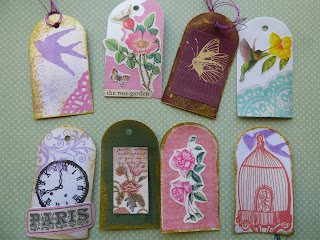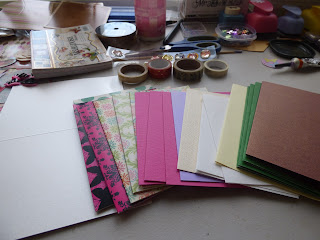I think handmade greeting cards are a special way of telling someone you care about them, because you have spent time and effort creating something especially for that person. You can make them personal and unique and tailor a card to a person's interests, hobbies, and passions.
I am not going to tell you how to make cards, rather this is just to share some cards that I have made in the hope that it will generate ideas, inspiration, and further creativity.
You need:
*Cardstock - you can buy pre-made cards, pre-printed cards, and blank card which you can cut down to size and fold in half. An A4 size sheet of card folds into an A5 size greetings card; an A5 sheet folds into an A6 size greetings card.
* Glue
To decorate your card, you can use a variety of things, such as...
*Printed paper to decorate - eg. scrapbooking paper; wrapping paper; postage stamps; illustrations from old books (old children's picture encyclopedias are great and you can often pick them up very cheaply at charity shops); images cut from magazines; images cut from old calendars...
*Stamps and ink
*Paper punches
*Washi tape
*Stick-on bling
*Embellishments - The Warehouse often has embellishments in the clearance bin for .97c for pretty things to stick on cards.
These are some of the cards I have made...
Stamps, embossing powder, paper punches, decorative paper
Decorative paper and washi tape
Pretty tissue paper and embellishments
Decorative paper cut into a teapot shape; coloured paper; gold outliner paint
Small placecard holder; embossed paper; stick-on bling; hand-made paper flower
Decorative paper; bird stamp; embossing powder
Embossed card using the Cuttlebug; paper punches; decorative paper; stamp and black ink
Embossed card using Cuttlebug; stamps and ink; decorative paper; stickers
Oriental paper; coloured paper embossed using Cuttlebug; silver wax rubbed over embossed image
Embossed geisha image using Cuttlebug; oriental paper
Decorative scissors; metallic paper; ribbon; stamp; handmade paper; gold outliner paint
Paper doily; image from old book
Pre-printed card; hand-drawn mixing bowl coloured in on plain paper and cut out; embellishments
Pre-printed card; embellishments
Decorative paper; stamp and ink
Sheet music printed on teabag stained paper and ripped while wet; metallic handmade paper; coloured paper; gold outliner paint
Decorative paper; paper punched flowers; bird stamp; cage cut from wrapping paper
Paper embossed using Cuttlebug; decorative paper; glitter; embellishments
Paper doily; image cut from an old book illustration
Pre-printed card; Mixer drawn onto plain paper and cut out; embellishments
Plain card folded in half; decorative paper; stickers; embellishments
Washi tape; embellishments; stick-on bling
Dress cut out of decorative paper; coloured paper
Pre-printed card; embellishment
Pear shape cut out of decorative paper
Plain card embossed using Cuttlebug; decorative paper; paper punch; stamp & ink
Pear shape cut out of decorative paper
Pre-printed card; Dress cut out of decorative paper
Scrapbooking paper; decorative paper; star sequins; washi tape
decorative paper; embellishments
Flocked paper; embellishments
Pre-printed card; washi tape; embellishments
Decorative paper; stamps & ink
Pre-printed card; scrapbooking paper
Scrapbooking paper
Scrapbooking paper
Pre-printed card; scrapbooking paper
Pre-printed card; scrapbooking paper
A5 Green card folded in half; old Winnie The Pooh calendar; paper punch; washi tape










































































